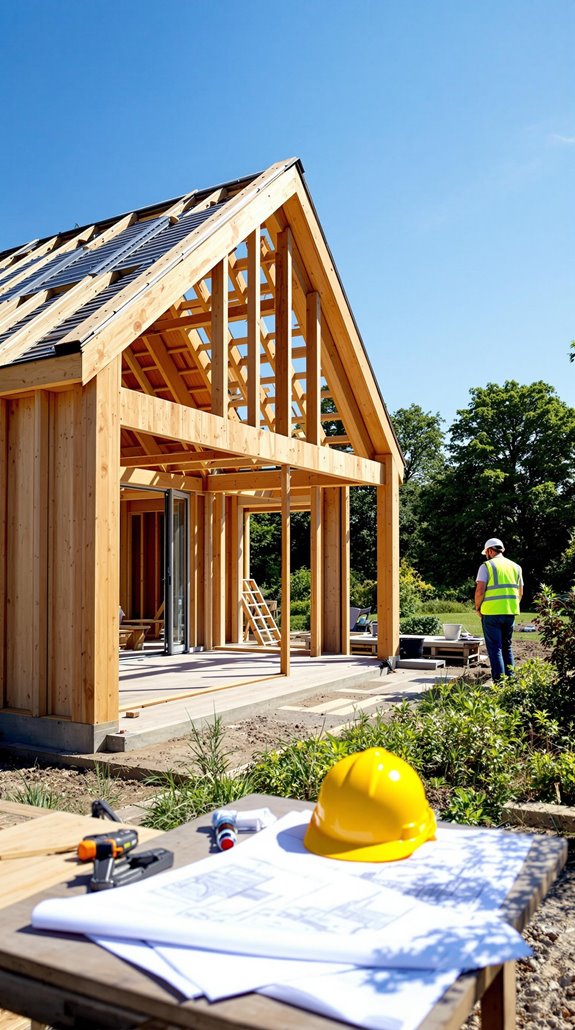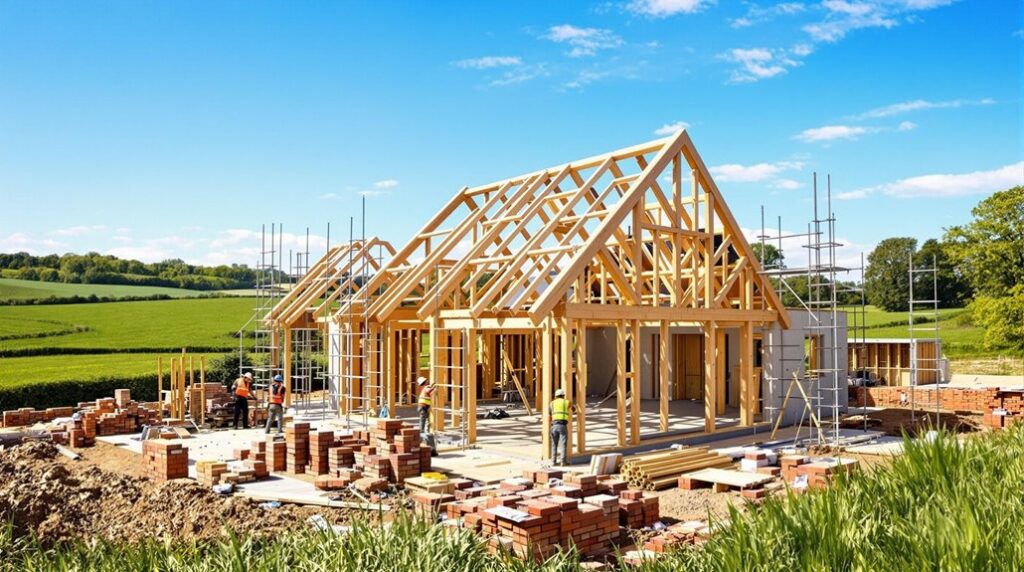I’ve witnessed countless aspiring homeowners transform their visions into reality through self-build projects across the UK, and I’ll tell you this—it’s not just about bricks and mortar. The process demands strategic planning, financial discipline, and a clear understanding of regulatory frameworks that can make or break your project. While the rewards of creating your perfect home are substantial, there’s a specific sequence of steps that separates successful builds from costly disasters that I need to share with you.
Key Takeaways
- Register on your local council’s self-build register to access future plot opportunities and demonstrate demand for self-build housing in your area.
- Secure specialized self-build mortgage financing covering up to 50% of plot costs and 100% of build expenses with funds released in construction stages.
- Commission professional surveys to evaluate soil stability, boundaries, and utilities before purchasing your plot to avoid costly surprises later.
- Budget £3,260 per m² for a standard build, including 35-45% for labour costs plus 10-15% contingency for unexpected expenses.
- Engage early with Local Planning Authority through pre-application discussions to identify constraints and improve planning permission approval chances.
Understanding the Current Self-Build Market Landscape

While the self-build market operates within broader housing trends, understanding current conditions will directly impact your project’s feasibility and timing. I’ll guide you through the key factors affecting self-builders today.
Housing starts dropped 9% quarter-on-quarter in Q1 2025, yet increased 22% year-on-year, indicating market stabilization after regulatory disruptions. You’ll benefit from the National Housing Bank‘s £16bn backing, which specifically targets SME financing gaps and self-build projects. Low-deposit mortgages are at their highest availability since 2008, though rates remain above 5% for smaller deposits. Mortgage approvals increased 3% in May 2025 compared to the previous year, suggesting improved lending confidence for potential self-builders. Additionally, understanding current market trends can help you make informed decisions about your project timeline and budget.
Large developers are increasing land acquisitions, improving plot availability for self-builders. However, regulatory uncertainty around planning reforms and potential material cost impacts from trade policies requires careful project timing. The current landscape favors prepared self-builders with solid financing strategies.
Registering Your Interest With Local Authorities
Once you’ve assessed the market landscape, registering with your local authority’s self-build register becomes your next strategic move. The Self-Build and Custom Housebuilding Regulations 2016 require councils to maintain these registers, creating a formal pathway for aspiring self-builders like us.
Both individuals and associations can apply, though you’ll need to meet basic eligibility criteria including being 18+ and a British citizen, EEA national, or Swiss national. Since April 2018, many authorities charge fees and implement local eligibility requirements.
This isn’t just bureaucratic paperwork—it’s strategic positioning. The register helps councils gauge demand and shape housing policies, directly influencing future plot availability. Your registration puts you in the system, ensuring authorities recognize our collective demand when planning serviced plot provision over their rolling three-year assessments. Councils may also implement local connection tests to assess your ties to the area through residency, family, or employment connections.
Finding and Securing the Perfect Plot

After completing your registration, securing the right plot becomes the foundation of your entire self-build project. I’ll guide you through the essential steps that successful self-builders follow.
First, I recommend commissioning professional surveys to evaluate boundaries, soil stability, and utility connectivity. You’ll need to verify planning permission status and assess ground conditions including contamination risks and drainage capacity. Don’t overlook legal access rights for construction vehicles. It’s also wise to consider regional price variations that can affect your overall budget for the self-build.
When evaluating development potential, I suggest consulting local authorities about planning feasibility and identifying constraints like conservation areas. Topographical analysis helps determine ideal building placement for sunlight exposure and drainage efficiency.
For acquisition, engage a solicitor to manage title transfers and restrictive covenants. Only exchange contracts after satisfactory surveys, planning verification, and financing confirmation through specialized self-build mortgages. Remember that stamp duty applies only to the plot purchase rather than the completed house value, providing potential savings compared to buying a finished property.
Calculating Realistic Build Costs and Budgets
With your plot secured, the next critical step involves calculating accurate build costs to establish a realistic budget for your self-build project. I’ll help you navigate the essential cost factors that’ll determine your final budget.
A standard 3-bedroom house averages £3,260 per m², totaling £306,454. You can reduce costs to £3,025 per m² with basic specifications or increase to £3,671 per m² for premium finishes. Location greatly impacts pricing—urban areas like London inflate costs by 15-25% compared to rural zones. Additionally, understanding regional price variations can help you plan more effectively.
Labour represents 35-45% of total expenses, while design complexity adds 8-15% for custom layouts. Don’t forget professional fees (8-12%), site preparation, utilities (£5,000-£15,000), and a 10-15% contingency fund. New-build homes benefit from zero-rated VAT on construction costs, providing significant savings compared to renovation projects. I recommend using digital tools for real-time quotes and considering phased construction to manage cash flow effectively.
Navigating Planning Permission Requirements
Planning permission forms the legal foundation that determines whether your self-build project can proceed, and understanding the regulatory framework will save you months of delays and potential rejections. I’ll guide you through the essential steps that successful self-builders follow.
Start with pre-application engagement with your Local Planning Authority. This fee-based service identifies land constraints early and clarifies local restrictions that vary considerably across regions. Research your LPA’s specific rules thoroughly—each authority enforces different requirements that can make or break your application. For instance, understanding the limits on home extensions can help inform your design choices.
Consider making plot purchases conditional on planning permission, though expect legal fees. For multi-plot developments, you’ll need conditions or obligations guaranteeing custom/self-build delivery. Always seek independent legal advice before entering Section 106 planning obligation contracts, and verify any pre-approved permissions directly with your LPA to avoid scams. Remember that planning permission is linked to land, not to you as the applicant, which means it transfers with the property.
Choosing Between Self-Management and Professional Help
How do you determine whether to manage your self-build project personally or hire professional help? The statistics reveal that only 3-8% of self-builders handle actual construction themselves, while half to two-thirds organize projects by hiring and managing subcontractors directly. This approach requires strong project management skills to mitigate inherent risks that both self-builders and lenders recognize.
Consider your experience level carefully. Professional support becomes essential for insurance requirements and anticipating unforeseen problems that cause budget overruns. Additionally, understanding building regulations is crucial to ensure compliance and avoid costly delays. However, 90.6% of self-builders recommend the process regardless of their management approach, with only 0.2% expressing dissatisfaction.
Your decision should balance personal capabilities against project complexity. While 85% finish on or slightly over budget, unrealistic planning often causes overruns—something professionals help avoid. The construction industry is increasingly developing packaged solutions to make self-build projects more accessible and manageable for homeowners.
Financing Your Self-Build Project

Securing adequate financing represents the most critical hurdle in your self-build journey, as traditional mortgages don’t apply to construction projects. You’ll need specialized self-build mortgages that release funds in stages as construction progresses. These typically cover up to 50% of plot costs and 100% of build expenses, with interest charged only on drawn amounts. Additionally, understanding the impact of lease extension costs is important in case you plan to buy the land with an existing leasehold.
However, there’s a catch: most lenders release funds in arrears, meaning you’ll need substantial upfront capital before receiving payments. Factor in stage release fees (around £100 per milestone) and valuation costs at each phase. Planning your cash flow meticulously is essential—delays can trigger penalty charges if you don’t repay within 12 months.
Consider government schemes like Help to Build, offering equity loans up to 20% of development costs for eligible first-time self-builders. Alternatively, you might explore remortgaging an existing property with little or no mortgage to raise the necessary funds for your build project.
Managing Construction Timelines and Milestones
Once financing is secured, your self-build project’s success hinges on masterful timeline management—a complex orchestration of sequential milestones that can stretch from 17 months to over 30 months depending on your approach.
I’ll share proven strategies that experienced self-builders use to maintain control. First, allocate 10-15% contingency time per phase—weather disruptions and supply chain volatility are inevitable. Digital project tools like Gantt charts become your command center for tracking dependencies weekly. An effective timeline also considers planning permissions as a crucial step that can impact your overall schedule.
Consider timber frame or SIPs systems to reduce superstructure time by 30-40%. I recommend concurrent trade booking during fit-out stages and pre-ordering materials with flexible delivery windows. Implement fortnightly contractor reviews to identify bottlenecks early, and secure utility connections during land purchase to prevent costly post-approval delays. For rural self-builds, expect longer timelines due to unique challenges including utility access issues and ground conditions.
Overcoming Common Self-Build Challenges
Despite the UK’s lower 10% self-build rate compared to mainland Europe’s 50%, the challenges that deter potential builders aren’t insurmountable—they’re simply obstacles that require strategic planning and realistic expectations.
I’ll break down the main hurdles you’ll face. Land acquisition tops the list—competition’s fierce, and serviced plots are scarce. Planning permission follows as your second major obstacle, with complex regulations and time-consuming processes. Financial constraints rank as the primary barrier, especially during economic downturns when 55% of builders feel the impact of energy price hikes and inflation. Additionally, it’s crucial to budget for potential hidden costs that could arise throughout the selling process.
Skills shortages mean you’ll likely need contractors—80-97% of self-builders rely on professionals rather than DIY approaches. Finally, awareness gaps particularly affect younger demographics, with only 9.9% of self-builders under 45 participating in this rewarding journey. While project delays affect nearly one-fifth of builders, only 1.5% abandoned projects entirely, proving that most challenges can be overcome with persistence.
Making Your Dream Home a Reality
While the UK’s self-build sector represents only 7-10% of new housing compared to Europe’s 50%, this gap signals untapped potential rather than insurmountable barriers. I’ll show you how to capitalize on this opportunity.
Target detached homes where self-builders hold one-third market share. With intermediate affordable housing starts dropping 27%, competition for resources has decreased while social rent starts surge 43%, indicating increased grant availability for community-led projects. Additionally, understanding property deal packaging can help you discover innovative financing options to support your self-build efforts.
The sector’s £2.3 billion materials expenditure demonstrates substantial market presence. You can leverage the 18,942 “tenure unconfirmed” starts offering flexible pathways for bespoke affordable projects. Historical volatility demands risk-mitigated timelines, but strategic alignment with current housing trends positions you advantageously. The government’s £39 billion commitment over ten years provides unprecedented funding certainty for affordable housing initiatives.
Your dream home isn’t just possible—it’s strategically positioned for success.
Conclusion
You’ve now got the essential framework to tackle your self-build project successfully. I’ve covered the critical steps from market analysis through completion, but remember that execution requires discipline and attention to detail. Don’t underestimate the importance of contingency planning and professional guidance throughout the process. Your dream home isn’t just a concept—it’s an achievable goal when you apply these strategies systematically. Start with your local authority registration and begin building your future today.
References
- https://www.gov.uk/government/news/new-homes-england-2024-to-2025-housebuilding-statistics-published
- https://assets.publishing.service.gov.uk/media/685bde09c07c71e5a87097f7/Housing_Statistics_June_2025.pdf
- https://www.gov.uk/government/publications/self-build-and-custom-housebuilding-data/data-release-self-build-and-custom-housebuilding-data
- https://buildingnewcommunities.co.uk/new-homes-england-2024-to-2025-housebuilding-statistics-published/
- https://www.self-build.co.uk/what-does-it-cost-to-build-a-house/
- https://commonslibrary.parliament.uk/research-briefings/sn02820/
- https://www.rsmuk.com/insights/advisory/uk-housing-tracker-outlook
- https://www.ons.gov.uk/economy/inflationandpriceindices/bulletins/privaterentandhousepricesuk/june2025
- https://www.peabodynewhomes.co.uk/blog/what-does-the-housing-market-look-like-in-2025/
- https://www.nationwidehousepriceindex.co.uk/reports/nationwide-house-price-review-and-outlook-for-2025-housing-market-resilient-despite-ongoing-affordability-challenges

